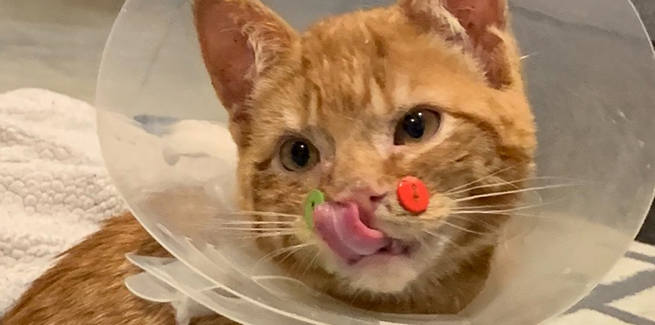Button up that kitty-cat

Rebecca Fellman, DVM, took one look at Juicebox and thought, “Buttons.”
Fellman was the veterinarian on duty when The seven-year-old feline was rushed to AAHA-accredited Massachusetts Society for the Prevention of Cruelty to Animals-Angell Animal Medical Center (MSPCA-Angell) shelter in Boston on January 20 after being attacked by the family dog. Among his injuries: multiple jaw fractures, lacerations, and a damaged palate.
As MSPCA-Angell’s adoption center veterinarian, Fellman had experience with the unusual technique, which involves using buttons to hold sutures in place postsurgery while preventing them from digging into the skin—she’d used the technique once before on a puppy who came into the shelter with a fractured jaw. Alice Ekerdt, DVM, a specialist in veterinary dentistry at MSPCA-Angell, had taught her the technique and supervised the puppy’s surgery.
But when Juicebox came in, Fellman was on her own. And the cat’s injuries were more extensive than the puppy’s.
“The fractures were similar but there were more of them,” Fellman told NEWStat. And she downplays the importance of the buttons: “You don’t have to use them. They’re really just to relieve possible irritation and prevent the sutures from digging into the skin.” She said any sort of soft material that would prevent the sutures from digging in would work. “Some people use bits of IV tubing. The buttons just happen to be a very convenient shape.” She said the technique’s not uncommon in veterinary dental surgery; in fact, the buttons she used were in stock and sterilized in the hospital’s dental department.
Rob Halpin, MSPCA-Angell’s director of communications, told NEWStat that Juicebox, who was relinquished by his owners after the attack, is doing well but hasn’t been adopted . . . yet. “It’s likely only a matter of days, as some 500 adoption inquiries have come in for him.”
Fellman’s not surprised that photos of the button-sporting cat went viral: “Colorful buttons just pop out, so it’s definitely charming.”
She added that her knowledge of the technique is especially useful in her job as a shelter veterinarian with many low-income clients because the cost of veterinary procedures is a real concern to pet owners: “It’s definitely a good thing to know about, because the materials certainly are affordable,” Fellman said. “Certainly cheaper than an implant or a metal plate.”
In a shelter, Fellman said, “every little bit helps.”
Photo credit: © MSPCA- [cid:62F28131-3AA8-46B5-8FF1-1E8308093D7E]



